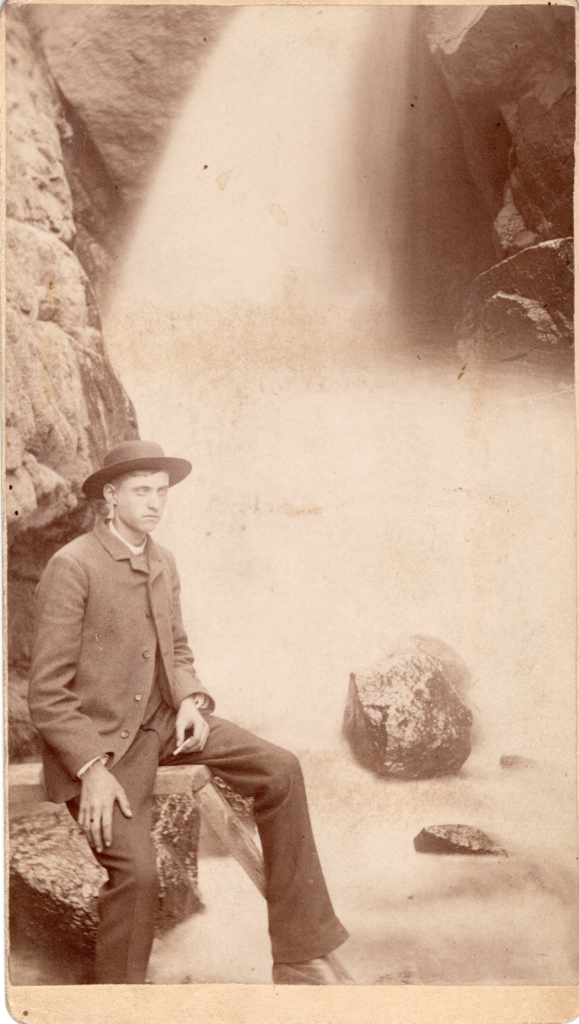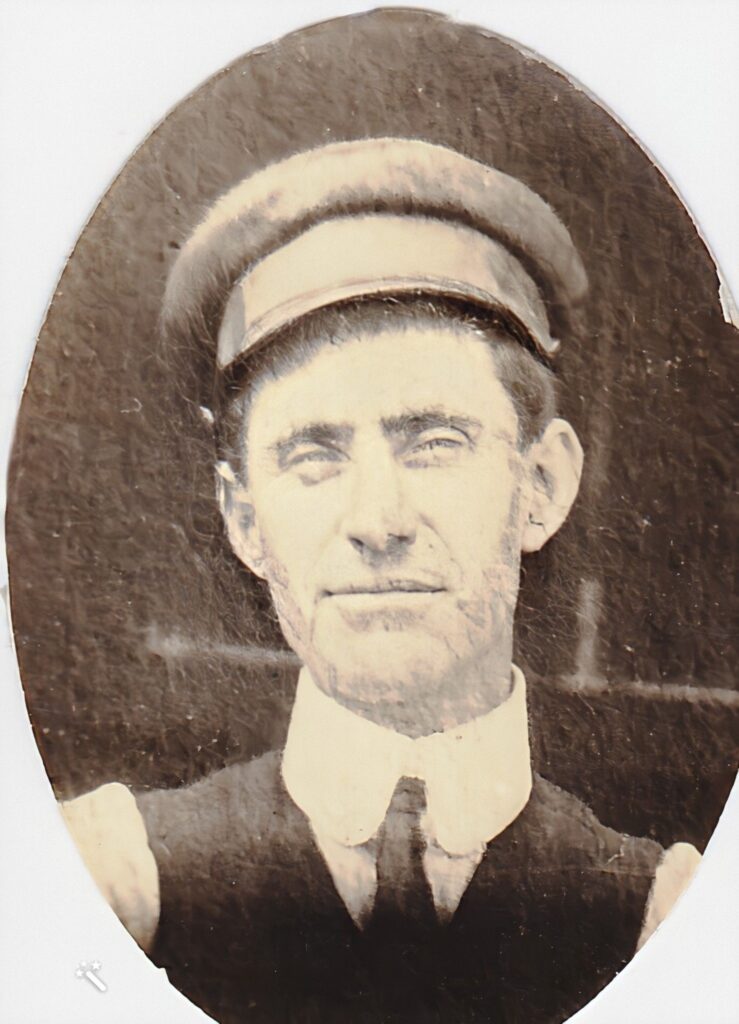
That’s one of the dramatic headlines for a news story in 2013. A year earlier, construction workers discovered the unmarked Santa Clara County Hospital cemetery in San Jose, California while working on the foundation for a new building in the hospital complex.
I found out yesterday from his death certificate that my great-grandfather, James Monroe Gibbs, was buried in that cemetery in 1917. He died of “Pulmonary Tuberculosis” at age 46 after being hospitalized for almost five months in the Santa Clara County Hospital. Apparently, no one claimed his body and he was broke, so they buried him in what is known as a “Potter’s Field” or pauper’s cemetery. None of the plain redwood coffins were marked, and no grave markers were placed. They estimate almost 1,500 people were buried there from about 1875 to about 1920.

In 1932, the half-acre cemetery was marked on a map of San Jose. On the next Master Plan in the 1950s, it was no longer marked. In 1960, the cemetery was “discovered” and a few people were moved. Then apparently, they were all forgotten again. In 1966, the hospital put an asphalt parking lot for employees on top of the cemetery.
Fast forward to 2012 and the “rediscovery” of the cemetery by the construction workers at Santa Clara Valley Medical Center, as it’s now called. They were making updates to the developed area for seismic safety standards. At first the County and/or medical center thought they could take out about 100 of the remains and then have them cremated. They wouldn’t be able to do anything about the rest of the remains under parking lots, buildings and roads.
An online article from 13 June 2013 in San Jose Inside says they had dug up 630 remains at that point. They found artifacts buried with the remains, but no clues to the names of the people. A separate article said the remains were too old and dried out for DNA testing to be useful. (Actually, DNA testing is so advanced at this point that only 3 cells are needed from remains to get a DNA profile and find relatives in DNA bases such as GEDmatch. Highly degraded DNA from remains can be used). Yet another article said the remains would be cremated and the ashes scattered as the county no longer re-buries remains.
The website of D & D Osteological Services says they were the primary subcontractor on the cemetery excavation from June 2012 through January 2014 and analyzed and wrote up 1,004 burials for pathology, skeletal inventory, dental inventory and disease. Obviously, I need to get a copy of that report! What a treasure trove of information for historians.
A memorial service was held with about 100 attendees. The hospital did not find or release any records with the names of the people who had been buried in their old cemetery. It was said some kind of memorial would be placed by the county to honor the people who had been buried in the forgotten cemetery.
I found two lists online of a small number of the people who had been buried there. Find-a-Grave listed 47 people known to be buried in the Santa Clara County Hospital Cemetery. Some were entered by descendants like me who found a long-lost ancestor. Another list has about 10 people on it. Thankfully, I found someone who took the time and effort to go through the county’s death certificates for that time period and list 1,220 people who were buried in the cemetery back in the day! I’m hoping to help get the names listed online on Find-a-Grave and other sites, so the people can be properly remembered and their descendants will be able to find out what happened to them.
Maybe you are wondering why my great-grandfather’s body was unclaimed by his family. He had one child, my grandma Bernice Gertrude Gibbs Anderson, who was born in Denver in 1900. Then my great-grandfather and great-grandmother split up. Their divorce was final in 1901. James moved away and according to his death certificate, lived in San Jose, California, for 16 years before his death in 1917. As far as we know, he never remarried or had any other children. We have not gotten any surprise DNA matches of previously unknown close relatives on this line! (Half-second cousins are close relatives in my book).
If he had contact with my grandmother, it was minimal. We have exactly three pictures of my great-grandfather, and I know, we are lucky to have them!

My mother and my paternal grandmother did a lot of genealogy work in the 1900s. A lot! My grandma thought for decades that her father had died in July 1918 in San Jose, California. There was a James M. Gibbs who died that day in San Jose, but it was a different James M. Gibbs who was much older. I think not knowing her father’s exact death date is the reason we didn’t have access to his death certificate earlier.
For those keeping track, his death certificate mostly lines up with the rest of his sparse paper trail, except for three things that are not deal-breakers as far as us being sure that this is the correct James Gibbs who is my great-grandfather.
1) It says he was single, but we know he was divorced.
2) It says his father, “Alex Gibbs,” was born in Scotland. Not exactly. My grandma’s paper trail indicates that for three generations prior to James, her Gibbs line lived in America, first seen in a Kentucky marriage record in 1819. The generation before that could have come from Scotland. On Alex Gibb’s maternal line, his grandmother was Catherine McKeown, born in 1794 in Glassary, Argyll, Scotland. They definitely have a claim to being Scottish on at least one side of the family. I have over 12 DNA cousin matches in the appropriate 4th cousin range who share Phelman Alexander’s parents with me as our most recent common ancestors, so we know there is no break in the biological line from that point to us.
3) It says James’s birthday was June 12, 1871. We thought it was July 12, 1871, as seen in my grandma’s family bible and other records. On the 1900 US Census in Denver, it says he was born in July 1871. A closer look at his age listed as 28 on his marriage date of June 21, 1899, lends support that his birthdate could actually be June 12th (not July). The 1900 US Census taken in Denver on June 11, 1900 is one day off on helping us out on this one. He is listed as 28-years-old. Had the census been taken one day later, if his birthday was known to be June 12th, then he would have been listed as 29-years-old!
I’m trying to identify how I feel about not knowing if James is still buried under the new hospital buildings and roads or if he was one of the ones excavated. Are his remains in the archives at California State University, Chico, where I believe they sent remains to be studied? I know what’s left of his body is not really him; his spirit is in a better place. I believe that. Still, I have a deep reverence for cemeteries and the way we show our respect by remembering our ancestors at their last place of rest. This did not turn into a place of rest for James and his many “neighbors” in the cemetery.
What are some ways we can honor the memory of these forgotten people? To start with, I updated my great-grandfather’s profile on FamilySearch.org, and on my Ancestry.com family tree and I created a memorial for him on Find-a-Grave.
